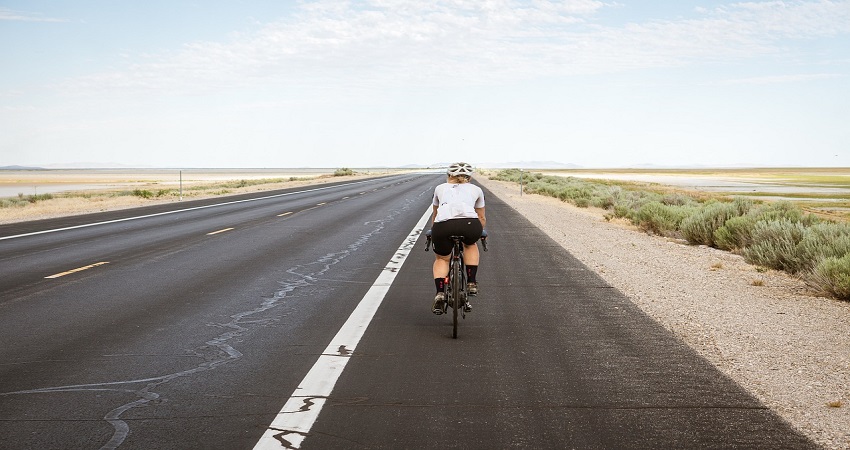
Yes, you can ride a bike on the highway. However, there are certain factors to consider for safety, such as traffic conditions, speed limits, and proper licensing, depending on the region.
Riding a bike is a popular mode of transportation and recreation for many people. It offers numerous health benefits and is an environmentally friendly way to get around. While most bikers typically ride on local roads or designated bike paths, some may wonder if it is possible to ride a bike on the highway.
We will explore whether riding a bike on the highway is permitted and safe. We will discuss important considerations and regulations to ensure the well-being of both cyclists and other road users. So, if you’re curious about biking on the highway, keep reading to find out more.
Safety Considerations
When considering riding a bike on the highway, it is crucial to prioritize safety. Being aware of the safety considerations can help prevent accidents and ensure an enjoyable experience on the road. Let’s explore two important aspects to keep in mind: speed restrictions and visibility, as well as the significance of wearing protective gear.
Speed Restrictions
Riding a bike on the highway requires a clear understanding of speed restrictions. It is crucial to comply with speed limits set for both vehicles and bicycles. By adhering to these limits, you minimize the risk of accidents and ensure a safe and harmonious environment for all road users.
It is important to note that speeding on a bicycle can be just as dangerous as speeding in a car. Maintaining a reasonable speed allows you to maintain control of your bike, react to unforeseen circumstances, and navigate the traffic effectively.
Visibility And Protective Gear
Visibility is key when riding a bike on the highway. Wearing bright colored clothing and reflective gear makes you more noticeable to other road users, especially in low-light conditions. This significantly reduces the chances of accidents caused by lack of visibility.
Investing in a good quality helmet is paramount to your safety. It not only protects your head in the event of a fall but also makes you more visible to others. Additionally, wearing elbow and knee pads, as well as sturdy footwear, can offer crucial protection in case of accidents or collisions.
While visibility and protective gear are essential, it’s essential to note that they’re just one aspect of ensuring safety on the highway. Riding defensively, obeying traffic rules, and remaining alert at all times are equally important.
Legal Regulations
Riding a bike on the highway can be a convenient way to travel, especially if you live in a city with heavy traffic. However, before you hit the open road, it’s important to understand the legal regulations surrounding biking on the highway. Local traffic laws and specific requirements for highway riding must be taken into account to ensure your safety and avoid any potential legal consequences.
Local Traffic Laws
When it comes to biking on the highway, local traffic laws play a crucial role in determining whether it is allowed or not. These laws can vary from one jurisdiction to another, so it’s essential to research and familiarize yourself with the regulations specific to your area. Here are a few key points to consider:
- Check if bicycles are allowed on the highway.
- Understand the speed limits for bikes on the highway.
- Know if there are any restricted areas where biking on the highway is prohibited.
- Be aware of any additional requirements or restrictions, such as wearing reflective gear or using specific bike lanes.
By adhering to the local traffic laws, you can ensure that you are riding your bike on the highway in a legal and safe manner.
Requirements For Highway Riding
In addition to local traffic laws, there may be specific requirements that need to be met for highway riding. These requirements are in place to enhance the safety of cyclists and other road users. Here are some common requirements to keep in mind:
- Ensure your bike is equipped with proper lights and reflectors for visibility.
- Observe any age restrictions for riding on the highway, especially for young children.
- Follow any helmet laws that may be in effect.
- Stay informed about any regulations regarding bike positioning within traffic lanes.
By fulfilling these requirements, you can minimize the risk of accidents and enjoy a smooth and lawful bike ride on the highway.
Benefits Of Highway Riding
Riding a bike on the highway can offer various benefits. Whether you are a commuting cyclist or an avid adventurer, highway riding can enhance your cycling experience in several ways. In this article, we will discuss two key advantages of riding your bike on the highway:
Efficiency And Speed
Riding a bike on the highway allows you to experience greater efficiency and speed during your journey. With fewer obstacles and intersections compared to city streets, highways provide smooth stretches of road where you can maintain a constant speed. This not only saves you time but also helps you reach your destination faster. Moreover, highways are typically well-maintained and free from traffic congestion, making it easier for you to ride without unnecessary interruptions.
In addition, the efficiency and speed of highway riding can also help improve your overall fitness. The consistent pedaling required to maintain speed on a highway can provide an excellent cardiovascular workout. This not only strengthens your heart and lungs, but also helps burn calories and improve your endurance levels. So, if you are looking to maximize your workout efficiency, highway riding might be just the exercise you need.
Access To Wider Areas
Beyond efficiency and speed, another major advantage of riding your bike on the highway is the access it provides to wider areas. Highways often connect different cities, towns, and regions, allowing you to explore new territories and discover scenic routes that may be inaccessible through regular city streets.
This means that you can plan longer rides, explore diverse landscapes, and embark on exciting cycling adventures that take you beyond the confines of your neighborhood. Whether you are seeking picturesque countryside views or challenging hill climbs, highways offer the gateway to a whole new world of cycling possibilities.
Moreover, with access to wider areas, you can also enjoy longer and uninterrupted rides, uninterrupted rides. This can be particularly beneficial if you are training for an endurance event or simply want to immerse yourself in extended periods of cycling bliss.
Challenges Of Highway Riding
Riding a bike on the highway presents numerous challenges, from high-speed traffic to lack of protective barriers, making it a risky endeavor. Safety precautions, including proper training and gear, are crucial for those who choose to ride on highways.
Before deciding whether you can ride a bike on the highway, it’s important to understand the challenges that come with it. While riding on a highway can offer a thrilling experience and provide a quick route to your destination, it also presents certain risks and obstacles that riders need to be aware of.
Increased Risk
Riding a bike on the highway exposes you to an increased level of risk compared to other roads. The higher speeds and heavy traffic on highways can make it more dangerous for cyclists. The potential for accidents is greater due to the mix of fast-moving vehicles and the limited visibility that drivers may have of cyclists.
Moreover, larger vehicles such as trucks and buses can create wind gusts that can affect your stability, especially if you’re riding a lightweight bike. This increased risk highlights the importance of exercising caution and following safety guidelines while riding on highways.
Handling Road Conditions
Another challenge of highway riding is dealing with different road conditions. Highways may have uneven surfaces, debris, potholes, or gaps in the pavement that can pose a threat to a cyclist’s safety. Additionally, highway roads are often designed with high curbs and minimal shoulder space, leaving little room for bikers.
It’s crucial to be capable of handling these road conditions to ensure a safe and smooth ride. One way to overcome this challenge is by equipping your bike with wider tires and adopting a more defensive riding style. Being aware of your surroundings and keeping a safe distance from vehicles can help you navigate through these road obstacles effectively.
In conclusion, riding a bike on the highway comes with its own set of challenges. Increased risk due to speed and traffic, as well as handling uneven road conditions, are factors that riders need to consider and overcome. However, with proper precautions and a proactive approach to safety, highway riding can be a rewarding experience for cyclists looking for a faster route to their destination.
Tips For Riding On The Highway
Riding a bike on the highway can be safe and enjoyable if you follow these tips. Ensure you wear proper protective gear, maintain a steady speed, stay in the right lane, and use hand signals to indicate your intentions. Always be vigilant and aware of your surroundings to ensure a smooth and safe ride.
Maintain A Consistent Speed
When riding on the highway, it is essential to maintain a consistent speed. This helps to ensure a smooth flow of traffic and makes it easier for other drivers to anticipate your movements. Keeping a steady pace also allows you to react quickly to any potential hazards that may arise.
Here are some tips to help you maintain a consistent speed:
- Start off slowly and gradually build up your speed.
- Avoid sudden acceleration or deceleration.
- Use the accelerator and brakes smoothly and evenly.
- Stay aware of your surroundings and adjust your speed accordingly.
- Keep a safe distance from the vehicle in front of you.
Use Signals And Mirrors
Using signals and mirrors is crucial when riding on the highway. These tools help communicate your intentions to other drivers, enhancing overall safety. Here’s how you can effectively utilize signals and mirrors:
- Before changing lanes or making a turn, always use your indicators to inform others.
- Check your mirrors regularly to be aware of vehicles approaching from behind.
- When switching lanes, look over your shoulder to ensure your blind spots are clear.
- Make sure your mirrors are properly adjusted to provide the best visibility.
By utilizing signals and mirrors correctly, you can enhance your awareness on the highway and reduce the risk of accidents.
Frequently Asked Questions Of Can You Ride A Bike On The Highway?
Can You Ride A Bike On The Highway?
Yes, you can ride a bike on the highway, but it is not recommended. Highways are designed for high-speed traffic, which can be dangerous for cyclists. It is better to choose designated bike paths or quieter roads for a safer biking experience.
Conclusion
Riding a bike on the highway comes with its own set of risks and considerations. While it may be legal in some places, it is important to prioritize safety and follow local traffic laws. Factors such as traffic volume, speed limits, and visibility should be taken into account before making the decision to ride on the highway.
It is always advisable to evaluate the conditions and assess the potential dangers before embarking on such a journey. Stay safe and exercise caution!



